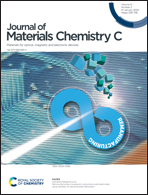Conductive ionogel for the study of charge transport through SAM-based junctions in aqueous solution†
Abstract
The urgency of the application of large-area molecular junctions in aqueous environments has garnered significant attention, driven by the necessity for biomolecular testing under physiological conditions and the monitoring of chemical reactions in solution. In this study, we synthesized a conductive ionogel as a top electrode to measure the electrical properties of self-assembled monolayers (SAMs). The SAMs for the test have different terminal groups, including –COOH, –CH3 and –F, exhibiting distinct affinities with water molecules. The variation in current density for each SAM can be attributed to the amount of water molecules between the electrode and SAMs. The electrical tests conducted in buffer solutions indicate that our tunneling process is dominated by electrons rather than ions, laying the foundation for testing biomolecules in physiological environments. We utilized ionogel electrodes for testing molecular junctions based on myoglobin and conducted temperature-dependent experiments with excellent repeatability. The exploration of ionogel electrodes contributes to our ability to conduct more complex measurements like rapid testing or drug screening, particularly in aqueous environments.

- This article is part of the themed collection: Molecular scale electronics


 Please wait while we load your content...
Please wait while we load your content...